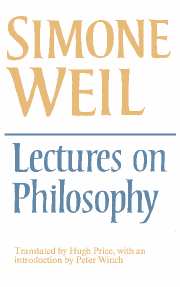Anne Reynaud-Guérithault's introduction
Published online by Cambridge University Press: 09 December 2009
Summary
Simone Weil is by now already well known and is portrayed by some as ‘the greatest mystic of the century’ and by others as ‘a revolutionary anarchist’. So I thought it would be of interest to introduce her, quite simply, as a teacher of philosophy.
She taught me at the girls' secondary school at Roanne during the school year 1933–4. Our class was a small one and had a family atmosphere about it: housed apart from the main school buildings, in a little summer house almost lost in the school grounds, we made our first acquaintance with great thoughts in an atmosphere of complete independence. When the weather was good we had our lessons under the shade of a fine cedar tree, and sometimes they became a search for the solution to a problem in geometry, or a friendly conversation.
I could waste time by reminiscing at some length about some strange rows that took place: the headmistress coming to look for marks and positions which Simone Weil usually refused to give; our orders to rub out the platonic inscription we had written above our classroom door: ‘No one admitted unless he knows geometry’.
But I share the distaste of Gustave Thibon for such reminiscences: like him, ‘I loved her too much for that’.
If ‘a brother cannot speak of his sister as a writer can about a fellow writer’, neither can a pupil speak in that way of a teacher she admired so much and who has had such a profound influence on her.
- Type
- Chapter
- Information
- Lectures on Philosophy , pp. 24 - 26Publisher: Cambridge University PressPrint publication year: 1978



